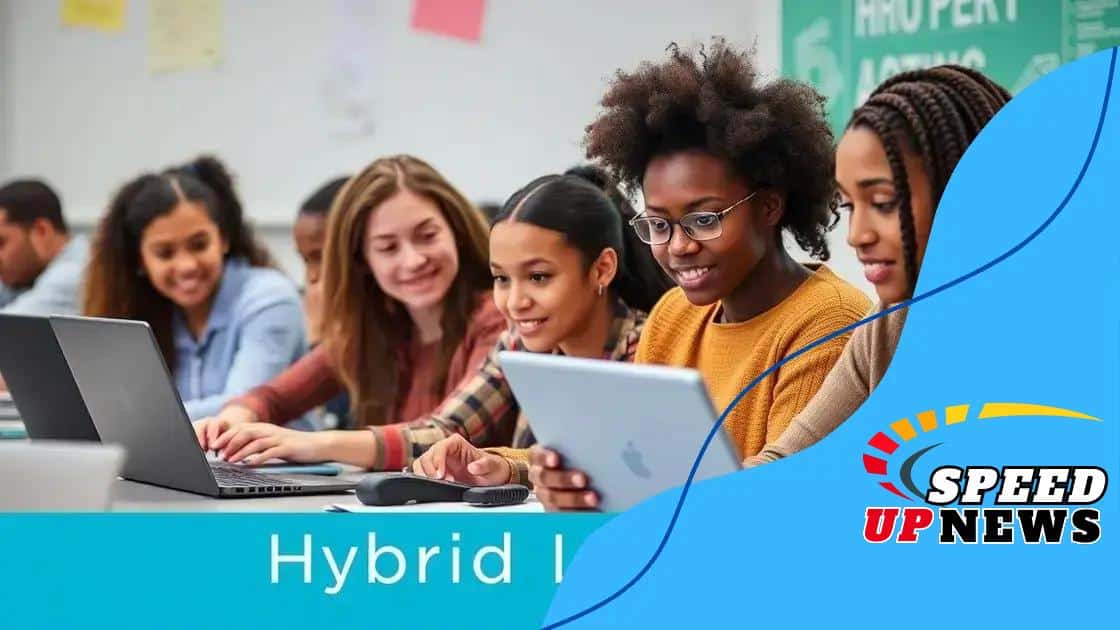Hybrid learning models and their effectiveness: a deep dive

Hybrid learning models combine traditional classroom experiences with online education, enhancing flexibility, engagement, and personalization for students while addressing the challenges of managing diverse learning environments.
Hybrid learning models and their effectiveness are becoming increasingly relevant in today’s educational landscape. Have you ever wondered how this approach could change your learning experience for the better? Let’s explore the nuances together!
What are hybrid learning models?
Hybrid learning models are innovative approaches that blend traditional classroom experiences with online education. This method allows students to enjoy the benefits of both worlds, making learning more flexible and accessible.
At their core, hybrid learning models integrate face-to-face instruction with digital resources. In a typical hybrid setup, students might attend classes in person some days of the week while engaging in online activities at home on others. This structure enhances student engagement and supports different learning styles.
Key Features of Hybrid Learning Models
These models offer unique features that cater to diverse student needs. Here are some characteristics:
- Flexibility: Students can learn at their own pace, balancing in-person and online coursework.
- Personalized Learning: Educators can tailor lessons to suit individual learning preferences, helping students to grasp complex topics.
- Resource Accessibility: Digital platforms enable easy access to a wealth of information and resources.
Moreover, hybrid learning enhances collaboration among students and teachers. Online discussions often foster a sense of community, encouraging students to share ideas and support each other. The actual classroom setting continues to play a vital role in skill development, especially social and emotional skills.
Examples of Hybrid Learning Models
There are several types of hybrid learning models that educators may choose from:
- Flipped Classroom: Students learn new content online, freeing up class time for interactive activities.
- Station Rotation: Students rotate through stations, some of which may involve online work.
- Flexible Environment: Classrooms are set up to allow students to choose where and how they learn.
As educators begin to implement hybrid learning models, they often report increased student motivation and achievement. These models not only blend learning environments, but also cultivate essential skills for the future.
The role of technology in hybrid learning
Technology plays a vital role in hybrid learning, enhancing both in-person and online education experiences. It serves as a bridge connecting students and teachers, enabling seamless transitions between different learning environments.
One of the primary technologies used in hybrid learning is the learning management system (LMS). These platforms allow educators to upload resources, track progress, and facilitate communication. Students can access lessons and submit assignments anytime, making learning more flexible.
Key Technologies Used in Hybrid Learning
Several tools and technologies support effective hybrid learning, including:
- Video Conferencing Tools: Applications like Zoom and Microsoft Teams enable live interactions, allowing students to participate in discussions regardless of location.
- Interactive Learning Tools: Platforms such as Kahoot! or Google Classroom provide engaging ways for students to learn and collaborate on projects.
- Virtual Reality (VR): This technology creates immersive learning experiences, helping students understand complex concepts through simulated environments.
In addition, technology fosters personalized learning experiences. Adaptive learning software assesses individual needs and tailors content accordingly. This approach helps students progress at their own pace, ensuring they master concepts before moving forward.
Benefits of Technology in Hybrid Learning
Embracing technology in hybrid learning offers numerous advantages:
- Enhanced Engagement: Interactive tools keep students motivated and involved in their learning journey.
- Increased Accessibility: Students can access materials from anywhere, accommodating different learning environments.
- Collaboration Opportunities: Technology enables students to collaborate on projects with peers globally, broadening their perspectives.
Ultimately, the strategic use of technology in hybrid learning creates a richer educational experience. As educators continue to innovate, technology will remain central to shaping the future of education.
Benefits of hybrid learning for students

Hybrid learning offers several benefits for students by combining the best of traditional and digital education. This flexible approach allows students to adapt their learning experiences according to their individual needs.
One key advantage is the personalized learning pace it provides. With hybrid learning, students can move through material faster or take extra time on challenging topics. This personalized approach often results in better understanding and retention of information.
Improved Engagement and Motivation
Students often feel more engaged in a hybrid setup. Here are some ways this engagement is fostered:
- Interactive Learning: Online resources often include quizzes and interactive activities that make learning fun.
- Variety of Learning Modalities: By utilizing both online and in-person instruction, students can benefit from different formats to enhance their learning.
- Real-time Feedback: Technology allows for immediate feedback, helping students identify areas for improvement quickly.
Moreover, hybrid learning encourages students to take ownership of their education. By accessing resources online, students learn to manage their time and study effectively. They can develop important skills like self-discipline and initiative, which prepare them for future academic and career success.
Increased Accessibility and Convenience
Another benefit is increased accessibility. Students can participate in class discussions from anywhere, removing barriers to education. This approach is especially helpful for those who may have mobility issues or live in remote areas.
- Flexibility: Students can attend class on days they feel well or access recordings of lessons if they miss a session.
- Diverse Resources: Hybrid learning provides access to a wide range of materials, from videos to articles, enriching the learning experience.
- Collaboration Opportunities: Students can collaborate with peers worldwide, broadening their perspectives and enhancing their learning.
Ultimately, the hybrid model supports a more inclusive and engaging educational environment, significantly boosting student outcomes.
Challenges educators face in hybrid environments
While hybrid learning offers many benefits, educators also face significant challenges in hybrid environments. Balancing in-person and online instruction can be complex and requires careful planning and organization.
One major challenge is ensuring all students are engaged, whether they are in the classroom or participating remotely. Teachers must find ways to keep everyone involved at the same time, which can be difficult. Some students may feel left out or disengaged, especially if they struggle with technology.
Time Management and Planning
Effective time management is crucial for educators in a hybrid setting. They must plan lessons that cater to both in-person and online students. This often requires additional preparation, making it essential for teachers to maximize their time efficiently.
- Lesson Adaptation: Adapting lessons for different formats can be time-consuming, requiring teachers to create multiple versions of the same material.
- Monitoring Engagement: It can be challenging to monitor participation and engagement levels across two platforms simultaneously.
- Assessments: Designing fair assessments that accurately reflect student understanding in both environments adds to the workload.
Additionally, educators must be prepared to address varying levels of technology access and digital literacy among their students. Some may struggle with online tools, which can hinder their learning experience. Teachers often need to provide extra support and resources for these students to ensure they can keep up with the curriculum.
Technical Issues and Training
Technical issues can also disrupt learning. Connectivity problems, software glitches, and unfamiliarity with online platforms can create barriers. Educators must be adept at troubleshooting and navigating these issues quickly.
- Training Needs: Ongoing professional development is essential for teachers to stay updated with the latest technologies.
- Resource Allocation: Schools need to ensure that educators have access to the necessary resources and tools to teach effectively in a hybrid environment.
- Support Systems: Having technical support on hand can help resolve issues quickly and minimize disruptions.
Despite these challenges, many educators find ways to innovate and enhance their teaching methods in hybrid environments. They continue to adapt and grow, ensuring that all students receive a quality education.
Future trends in education and hybrid models
The future of education is evolving rapidly, with hybrid models leading the way in transforming how students learn. As technology continues to advance, these models are becoming more flexible and accessible, catering to diverse learning needs.
One significant trend is the growing integration of artificial intelligence (AI) into hybrid learning environments. AI-powered tools can assess student performance in real-time, providing personalized feedback and tailored learning experiences. This technology allows educators to identify areas where students may need extra support and adjust their teaching strategies accordingly.
Increased Use of Virtual and Augmented Reality
Another exciting trend is the incorporation of virtual (VR) and augmented reality (AR) into hybrid classes. These immersive technologies can create engaging learning experiences that bring subjects to life. For example, students can explore historical sites or conduct science experiments in a virtual lab, all from the comfort of their homes.
- Enhanced Engagement: VR and AR provide interactive experiences that capture student interest.
- Realistic Simulations: Learning through simulations can help students grasp complex concepts more effectively.
- Accessibility: These technologies can make learning experiences accessible to students around the world.
Moreover, the trend toward more **collaborative learning** is gaining momentum. Hybrid models foster collaboration among students, regardless of their physical location. Online platforms enable group projects and discussions, allowing students to learn from each other and develop essential teamwork skills.
Emphasis on Lifelong Learning
As the job market continues to change, there is a growing emphasis on lifelong learning. Hybrid models provide the flexibility necessary for individuals to continue their education beyond traditional schooling. Adult learners can access courses that fit their schedules, making it easier to upskill or reskill for new job opportunities.
- Flexible Learning Paths: Students can choose courses that align with their career goals and personal interests.
- Online Certifications: Many institutions now offer online certificates that are valuable in the job market.
- Networking Opportunities: Hybrid learning allows students to connect with professionals and peers globally, expanding their networks.
Finally, there will be a focus on developing social-emotional learning (SEL) programs within hybrid education. These programs aim to equip students with essential life skills, such as empathy and resilience, crucial for success in both personal and professional settings.
FAQ – Frequently Asked Questions about Hybrid Learning Models
What are hybrid learning models?
Hybrid learning models combine traditional classroom experiences with online education, allowing students to learn in both environments.
How does technology enhance hybrid learning?
Technology, including AI and VR, creates interactive and personalized learning experiences, increasing student engagement and understanding.
What are the benefits of hybrid learning for students?
Students enjoy flexibility, personalized pacing, collaboration opportunities, and access to a wide range of resources.
What challenges do educators face in hybrid environments?
Educators must manage time effectively, engage students in both settings, and troubleshoot technical issues to ensure a smooth learning experience.





